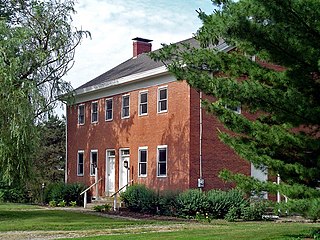
Heber-Overgaard is a census-designated place (CDP) in Navajo County, Arizona, United States. Situated atop the Mogollon Rim, the community lies at an elevation of 6,627 feet (2,020 m). The population was 2,898 at the 2020 census. Heber and Overgaard are technically two unincorporated communities, but as of the 1990 census, their proximity led to the merged name of "Heber-Overgaard".

Holbrook is a city in Navajo County, Arizona, United States. According to the 2010 census, the population of the city was 5,053. The city is the county seat of Navajo County.

Fairbank is a ghost town in Cochise County, Arizona, next to the San Pedro River. First settled in 1881, Fairbank was the closest rail stop to nearby Tombstone, which made it an important location in the development of southeastern Arizona. The town was named for Chicago investor Nathaniel Kellogg Fairbank who partially financed the railroad, and was the founder of the Grand Central Mining Company, which had an interest in the silver mines in Tombstone. Today Fairbank is located within the San Pedro Riparian National Conservation Area.

Samuel Oldknow (1756–1828) was an English cotton manufacturer.
Tres Alamos is a ghost town in Cochise County in the U.S. state of Arizona. The town was settled in 1874 in what was then the Arizona Territory.

The Apache Railway is an Arizona short-line railroad that operates from a connection with the BNSF Railway at Holbrook to the Snowflake Mill near Snowflake, Arizona, 38 miles (61 km). The APA was acquired by Catalyst Paper from Abitibi Consolidated in 2008. The Snowflake paper mill shut down permanently on September 30, 2012. In late 2015, the railway was purchased out of bankruptcy by a group including Aztec Land & Cattle Company and Midwest Poultry Producers, L.P., thereby avoiding a shutdown and scrappage of the line. The railway continues to operate, and its revenues are driven primarily by car repair and storage. The railway's freight revenues have not yet recovered from the shutdown of the Snowflake paper mill then owned by Catalyst, although efforts to enhance them continue.

Catalyst Paper Corporation is a pulp and paper company based in Richmond, British Columbia. It operates five pulp mills and paper mills, producing a combined 1.8 million tonnes of paper and 491,000 tonnes of market pulp annually. The mills mostly produce magazine paper and newsprint.

Pinedale is an unincorporated community in Navajo County, Arizona, United States. The population was 487 at the 2010 census. The elevation is approximately 6,500 ft (2,000 m) and it is part of the Mogollon Rim mountain range.

Kentucky Camp is a ghost town and former mining camp along the Arizona Trail in Pima County, Arizona, United States, near the community of Sonoita. The Kentucky Camp Historic District is listed on the National Register of Historic Places and has been since 1995. As it is located within Coronado National Forest, the United States Forest Service is responsible for the upkeep of the remaining buildings within the Kentucky Camp Historic District.

Charleston is a ghost town in Cochise County in the southeastern part of the U.S. state of Arizona. It was occupied from the late-1870s through the late-1880s, and was located in what was then known as the Arizona Territory. Located on the west bank of the San Pedro River, Charleston's economy was based on milling silver ore mined from nearby Tombstone in the community of Millville, located directly across the river.

Contention City or Contention is a ghost mining town in Cochise County in the southeastern part of the U.S. state of Arizona. It was occupied from the early-1880s through the late-1880s in what was then known as the Arizona Territory. Only a few foundations now remain of this boomtown which was settled and abandoned with the rise and fall of silver mining in and around the area of Tombstone.

The Whitewater Shaker Settlement is a former Shaker settlement near New Haven in Crosby Township, Hamilton County, Ohio, United States. Established in 1824 and closed in 1916, it was listed on the National Register of Historic Places in 1974 as a historic district.

Agriculture in Sudan plays an important role in that country's economy. Agriculture and livestock raising are the main sources of livelihood for most of the Sudanese population. It was estimated that, as of 2011, 80 percent of the labor force were employed in that sector, including 84 percent of the women and 64 percent of the men.

Abel Stearns was an American trader who came to the Pueblo de Los Angeles, Alta California in 1829 and became a major landowner and cattle rancher and one of the area's wealthiest citizens.

Rancho Temescal was a farming outpost of Mission San Luis Rey de Francia, one of the 21 Franciscan missions established in California by Spain during the late 18th and early 19th centuries. The Mission was located on the coast where Oceanside, California, is today. The Rancho was settled in 1819 by Leandro Serrano, and became the first non-native settlement within the boundaries of what would become Riverside County, California.
The Casa Grande Dispatch is an American newspaper published Tuesdays, Thursdays and Saturdays in Casa Grande, Arizona. Circulated in Casa Grande and surrounding areas, it is Pinal County's largest paid circulation newspaper. It has been published under the current ownership, Casa Grande Valley Newspapers Inc. since 1963, and in January 2012 it began its 100th consecutive year of publication.

Aztec Land and Cattle Company, Limited ("Aztec") is a land company with a historic presence in Arizona. It was formed in 1884 and incorporated in early 1885 as a cattle ranching operation that purchased 1,000,000 acres in northern Arizona from the Atlantic & Pacific Railroad. It then imported approximately 32,000 head of cattle from Texas and commenced ranching operations in Arizona. Because Aztec's brand was the Hashknife, a saddler's knife used on early day ranches, the company was known more famously as The Hashknife Outfit. The company has been in continuous existence since 1884.

Wilford, Arizona is a ghost town in Navajo County, Arizona, United States, located approximately 7 miles south of Heber-Overgaard, along Black Canyon Rd. The town was settled in April 1883 by a group of Latter-day Saints from the failed Brigham City settlement. Wilford was eventually abandoned due to years of overgrazing by cattle. The last residents moved out in 1926.
Snowflake Mill was a pulp mill and paper mill located in the US town of Snowflake, Arizona. The mill had two paper machines which produced 339,000 tonnes of newsprint and uncoated fine paper. It sourced its fiber from two deinking pulp lines. The mill had 293 employees as of 2014. Transport to and from the mill was carried out on the Apache Railway.

Calabasas is a former populated place or ghost town, within the Census-designated place of Rio Rico, a suburb of Nogales in Santa Cruz County, Arizona.




















